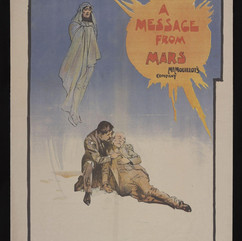Albert Morrow: The Comber Cartoonist!
- Michael Burns

- Jul 19, 2024
- 3 min read
This week's blog post is to highlight a little known historical figure born in Comber, Albert Morrow- a cartoonist and illustrator- chiefly known for his magazine/book illustrations and theatre posters.
Albert was born on the 26th April 1863 in Comber and grew up in Belfast. He was the eldest son of George Morrow, a painter & decorator from Belfast and indeed his sons must have inherited some artistic talent from their father, with Albert and four of his seven brother's (George, Jack, Edwin & Norman) all becoming illustrators.
Morrow attended the Belfast Model School before learning his trade at the Belfast Government School of Art (1878-1881) before attending the National Art Training School in 1882. While still a student his work began to appear in magazines varying in theme and including portraits, landscapes and industrial scenes. In the 1880s, he created a series of illustrations for The English Illustrated Magazine accompanying articles focusing on 'Cutlery and Cutlers at Sheffield' (1881) and 'China-making at Stoke-on-Trent' (1884)- designed to give an insight into these skilled Victorian crafts.
Yet, other illustrations highlight the age of the industrial revolution, far removed from the peaceful porcelain and cutlery workshops of England. These industrial scenes emphasise the mechanics of industry and new technology of the Victorian age, much darker images featured in 'Iron and Steel Making in South Wales' (1884).
Albert exhibited his works across the UK and beyond, exhibiting in Belfast, Dublin, Paris and even the Royal Academy of Arts in London. He also took an active role in the local arts scene, becoming a member of the Belfast Arts Society and founding member of the Ulster Arts Club. Albert also designed book covers and illustrations for many later Victorian & Early Edwardian novels, ranging in genre from thrillers such as Kidnapped by Smugglers by Frederica J. E. Bennett (1931) or adventure novels such as Adrift in the Pacific by Jules Verne (1928 re-issue). While many of these novels and authors are lost to time, Jules Verne was not the only famous literary name from which Morrow drew inspiration. In 1902, Albert created a promotional poster for the American release of Sir Arthur Conan Doyle's 'Sherlock Holmes' story The Hound of the Baskervilles in the US Strand Magazine an image that remains iconic of the story today.

While Albert was a prolific illustrator for magazines and other literary works, he was perhaps best known for his Illustrated posters. Creating many illustrations to advertise plays in the great theatres and companies of the time. The Belfast News-Letter reported on his death that Albert had;
'devoted himself to poster work, in which he showed marked ability both in regard to design and colour schemes. His posters were, indeed, a feature of the hoardings for some years, and in that branch of art... he could claim to have been a pioneer'.
Belfast News-letter 28th October 1927
Albert died at his home in West Sussex on the 26th October 1927, aged only 64. He had drawn countless illustrations for many top magazines, authors and theatres across the world. His works survive today in the institutions such as the Ulster Museum, Victoria & Albert Museum in London and even the Musée Des Artes Décoratifs (Museum of Decorative Arts) in Paris. Below are a selection of his theatre posters and magazine covers.
































Comments